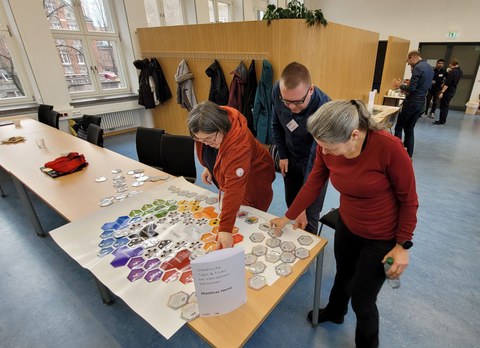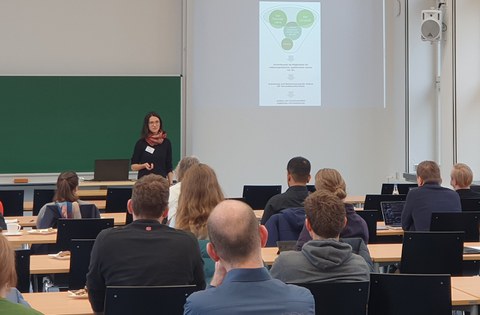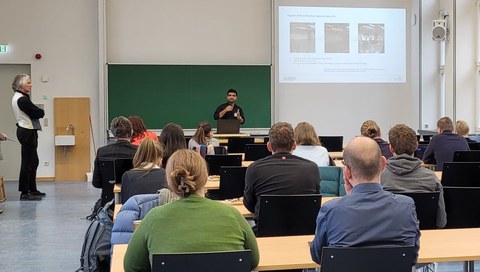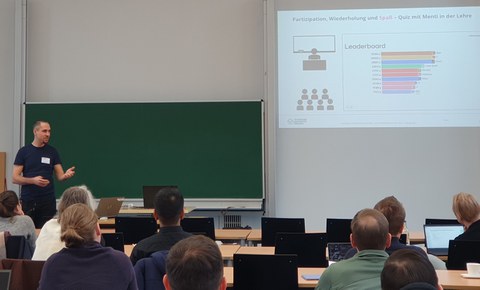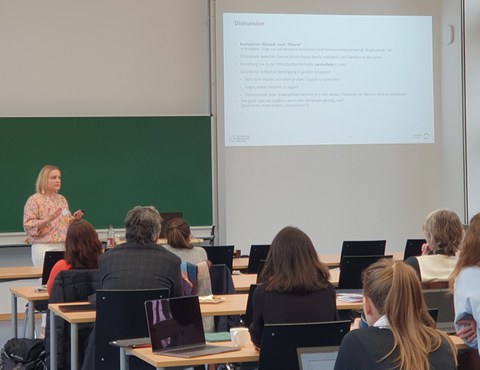Throwback: Gamification
The third networking and Digital Teaching workshop on gamification took place on January 26, 2024. Here you will find a review of the most important topics.
Table of contents
Introduction to Gamification
Matthias Heinz from the Center for Interdisciplinary Learning and Teaching (ZiLL) established the topic of gamification. He defined gamification in teaching, gave an overview of game theories, and elaborated on the most important rules to be observed.
Presentation slides:
Matthias Heinz: Einführung in Gamification
Further information about gamification (Project Gami|cation)
The Most Important Statements:
- Gamification in teaching is not the creation of a virtual world, but the use of ludic elements, which does not have to be extravagant.
- Gamification is also used in everyday life, for example by collecting payback points and air miles or through learning apps – it works well!
- The objective of gamification is to bring about positive changes in behavior in order to achieve better learning outcomes.
- One important mechanism is the “flow principle:” the level of difficulty should increase ideally and must not overtax or demand too little from the learners.
-
Another theory describes that social integration and self-determination (the ability to act autonomously and improve oneself) lead to more motivation to learn.
- A distinction can be made between six types of players: Players collect rewards for themselves, Socializers like to work together in teams, Disrupters work against the system or want to develop it further themselves, Philanthropists like to help others altruistically, Free Spirits want to be able to explore freely and Achievers want to improve themselves and collect as many points as possible. Many people can be assigned to several types. Gamification should therefore appeal to as many types as possible.
- Gamification can entails risks of manipulation or the disclosure of private information.
- The things most commonly used in gamification (points, leaderboards, badges) are only extrinsically motivating. They perform poorly in a learning context because they can also be demotivating – for example, unattainable leaderboards.
- Classic gamification elements are OPAL-ONYX, Kahoot, Quizlet, learning apps, and H5P.
Discover Biodiversity with Actionbound
Anne Göhre, from the Chair of the Didactics of Biology, reported on her project which offers interactive rallies for students and the public in the Botanical Garden. She used the Actionbound app for this.
Presentation slides:
Anne Göhre: Biodiversität endecken mit Actionbound
The Most Important Statements:
- Actionbound is an app that is often used in museums or learning locations outside the school. It allows you to create location-based rallies in which you can complete tasks and collect points.
- The individual tasks (“Bounds”) can be created quickly and easily. Users are ludically navigated between the locations and tasks. Lecturers can view the results. The licensing costs for using the app are reasonable, but often difficult to calculate. For example, a single course costs 150 euros, an entire faculty pays 690 euros per year.
- Tasks in Actionbound can include: finding a location and entering GPS coordinates, reading information, answering quizzes with estimation questions, and answering open-ended questions.
- An Actionbound quiz was implemented in the Botanical Garden to promote self-study. On the one hand, tasks were created by employees for students based on clearly defined learning objectives and contents. In addition, students were also asked to complete individual tasks in teams and give each other feedback. This earned additional points for the exam. Meanwhile, the resulting educational offer is also available to the public.
- The experience of setting it up was predominantly positive: the photo quest (“Find the location and take a photo”) in particular was very well received, as were multiple choice tasks. The GPS location in the botanical garden was too inaccurately measured for some tasks (accuracy is only about 6 meters). There was little response to audio, video and text tasks, which would have taken more time to complete. In addition, tasks that called for forming and expressing one's own opinion were often skipped.
- Further tips: The motivation of the students was initially lower than expected but was increased through concrete incentives (points for the exam). The students needed significantly more time than planned to complete the tasks – the estimated completion time should be scaled accordingly. Despite free periods, the students did not work on the tasks independently – at least at the beginning, joint and supervised work is necessary to introduce everyone to the modus operandi.
Gamification and Mixed Reality in Geomorphology
Nikolas Prechtel from the Institute of Cartography and Krishnan Peringottukurussi Chandran from the Faculty of Computer Science shared their initial experiences of implementing mixed reality in geomorphology teaching.
Presentation slides:
The Most Important Statements:
- Geomorphology deals with the earth's relief and its diverse characteristics. The three-dimensional shapes and their properties are usually documented on maps in 2D. Students have to make observations in the field and train to analyzing them.
- Idea: Students complete a team game in order to get introduced to a specific topic and share their knowledge with others. A 3D classroom combines gamification and mixed reality to teach students the theoretical basics of geomorphology. The 3D classroom is only intended to support the experience in the field and not replace it.
- Students have to recognize relief features and assign them to the appropriate memory cards (illustrations, geographical maps, texts). Other tasks include modifying a 3D cuboid into a relief and define features in the 3D relief. The group work leads to a mutual exchange of arguments and knowledge.
- The games worked well in the 3D classroom and in the field, and the students were able to deepen their knowledge more quickly. The 3D classroom enables low-threshold familiarization with morphology and is accessible, but cannot replace field trips. Setting up the mixed reality environment is relatively time-consuming, but can be used in a variety of ways afterwards.
Quizzes with Mentimeter
Django Adam from the "Friedrich List" Faculty of Transport and Traffic Sciences offered a practical insight into his experience of using Mentimeter as a quiz tool to activate students.
Presentation slides:
Django Adam: Partizipation, Wiederholung und Spaß – Quiz mit Mentimeter in der Lehre
The Most Important Statements:
- Mentimeter is suitable for live surveys in lectures to encourage students to think and participate. Students who are otherwise passive consumers are encouraged to actively engage with the subject matter.
- After each chapter, students are asked to design their own quiz questions on the subject matter. These questions are curated and sorted by the teacher and used in the next course. The answers are discussed and debated. The students then vote on the best questions.
- A quiz gradually builds up over the course, which is also used partly for the exam.
- By developing the questions themselves, students are encouraged to get involved, understanding is promoted and the subject matter is repeated directly in and after the courses. Further repetition of the material takes place by using the quiz for exam preparation.
- A quasi-anonymous leaderboard without real names is intended to provide additional motivation for students.
Digital Tools for Effective Learning in Large Groups
The lecture series ended with Isabell Lippert from the Chair of Business Information Systems, esp. Business Engineering. She spoke about her course “Introduction to Business Informatics” with elements of interactive gamification and, sometimes, the negative experiences with their use.
Presentation slides:
Isabell Lippert: Digitale Hilfsmittel für effektives Lernen in Großgruppen
The Most Important Statements:
- The "Introduction to Business Informatics" module, which is attended by many first-semester students from a wide range of degree programs, needed to be enriched with gamification elements. Around half of the 300 enrolled participants regularly attend the on-site lecture, on-site exercise courses are carried out with around 50 people, and an online exercise course is attended by around 20 people.
- Among other things, estimation questions (“How many parcels does Amazon send per day?”) and other quiz questions are compiled with the Slido tool. Voluntary group homework ("Put together a gaming PC") is designed to encourage students to engage with the subject matter and work as a team.
- Small gifts (chocolate santas, promotional items, and office supplies) are offered as prizes for successful participation.
- The quiz enjoys a high level of participation and gives students an impression of how exam tasks could be designed. The voluntary homework assignment is completed by some people.
- We frequently gathered very negative experiences with some of the gamification elements: the free texts of the Wordcloud were sometimes misused with offensive terms, some tools were exploited for fun – so the group dynamic can tilt towards the "class clowns".
- The students' expectations are sometimes very high, but participation in the courses is frustratingly low. Students want more “shorts” (see Youtube) that only require a short attention span.

